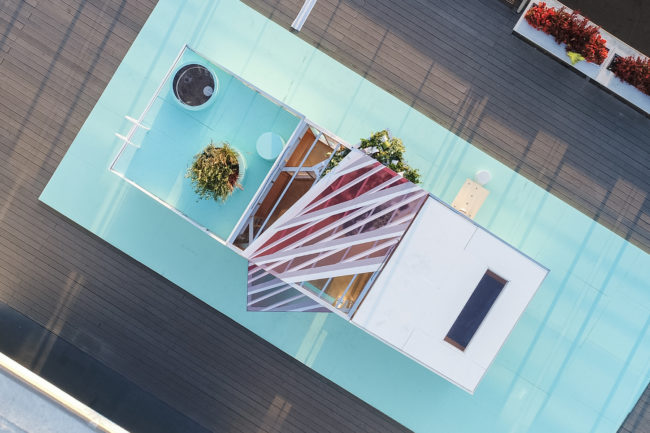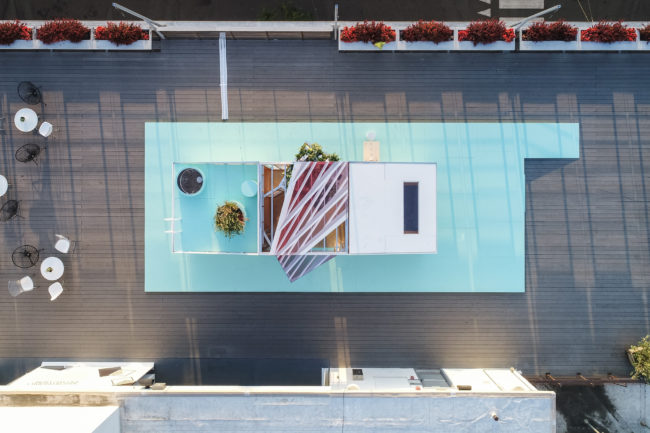Tiny homes have become extremely popular in recent years as housing prices climb and fewer houses remain open for rent or purchase.
These mini urban cabins, usually smaller than 400 square feet, are designed to maximize space efficiency while reducing the overall footprint of the home. They come in all shapes and sizes, from trailers to homes to cabins and even 3D printed houses.
BMW is planning on launching a new entry in this industry later this year — the MINI Living Urban Cabins.
What Are MINI Urban Cabins?
While tiny homes can be as small as 100 square feet, most of them tend to sit around the 300 to 400 square foot mark. The MINI Living Urban Cabins are even smaller, coming in at only 160 square feet. This prototype is currently on display in Beijing.
The home features a living area and bedroom in one end of the building and a kitchen and bathroom on the other, all wrapped around a central courtyard that provides a lot of open space and makes the interior look even bigger.
The interior walls are convertible and can be rotated down into a makeshift office. Windows and angled skylights provide a ton of natural light for the interior, keeping energy costs down and creating the illusion of space.
Beds and other large furniture items are designed to be rolled into the walls when not in use, allowing you to maximize your interior space. Pegboard-style walls also enable the resident to create custom shelf space for additional storage. Add a laptop and some decent Wi-Fi, and you can easily turn one of these tiny homes into a functional living space.
Turning a Tiny House Into a Tiny Home
If you’re used to living in a typical house or apartment — the smallest of which being probably somewhere between 600 and 800 square feet — how can you make the transition into a tiny house?
It’s a lot easier than most people think. These small houses are designed to optimize both space and storage, so even if you can’t bring all of your big furniture to your new home with you, you should have plenty of space for things like clothes, knickknacks and other belongings.
Instead of keeping a huge library of CDs and DVDs, consider transitioning to digital and installing a virtual assistant like Google Home. With a simple voice command, you can ask your assistant to play anything from your digital library — even video if you have a TV equipped with a Google Chromecast.
Plus, you’ll have the power of Google at your fingertips to find weather, traffic, recipes and other information without ever opening your laptop or picking up your phone.
If you’re moving around a lot, which is an option with some tiny home designs, setting up an account with the local utility company just isn’t feasible. Verizon’s new 5G mobile internet could be the solution once they’ve worked the bugs out of the system and roll it out nationwide.
Right now it sounds like a good idea, but it’s only available in four cities, and it isn’t ready for full-scale implementation yet.
Could You Live in a MINI Living Urban Home?
Now, on to the big question — could you live in one of these new Mini Living Urban Cabins? That really depends on your needs.
It wouldn’t be an ideal environment for more than one or two people, but two people can fit if they’re very comfortable with one another. Raising kids, for example, would be next to impossible in a tiny home, but for single individuals and childless couples, this trend can be a great way to reduce housing costs.
As for me, I’m looking forward to these MINI living homes becoming available to the public and finding out what they’re going to cost. It’s always been a tentative part of my plan to get away from the traditional 2,000 square foot home and invest in a tiny home — preferably one with wheels so that I can move it around the country when I get tired of my current zip code.
If you’d like to see how you’d fare in a small-square-footage environment, you’ll be happy to know that BMW is opening their first operational development in April of next year. The abandoned paint factory that’s been converted into an apartment complex will also feature communal workspaces and recreational facilities. This facility is based in Shanghai though, so you might have to renew your passport before you can check it out.
Whether you choose to live in a traditional home, mobile home, tiny home or MINI Living Urban Home, you can’t deny that the face of the housing market is changing, and we’re excited to see the shift. The less land we develop for housing, the better it will be for the environment.
Recent Stories
Follow Us On
Get the latest tech stories and news in seconds!
Sign up for our newsletter below to receive updates about technology trends
















